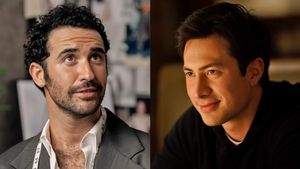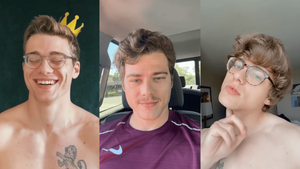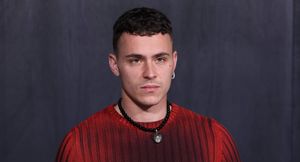Visible: Out on Television is one of the most ambitious productions yet to chronicle the history of the LGBTQ movement -- in this case, through the lens of how it was reflected on television.
The fascinating five-part docuseries, directed by Ryan White, begins in the 1950s when the only mentions of homosexuality on television involved trial coverage related to the Lavender Scare. It ends with "the new guard" in the present day, when there is an unprecedented number LGBTQ characters on TV -- yet still, the fight for visibility, with its end goal of equality, is far from over.
Each chapter of Visible moves chronologically, drawing from testimonies of nearly 100 of the most prominent LGBTQ celebrities and activists in the United States -- even Ellen DeGeneres gets serious to sit down for the series. Collectively, they broadcast what queer representation was like on TV in each era from the perspective of the viewer and, oftentimes, the face on the other side of the screen looking back.
Visible spans decades. But it also took nearly a decade in its journey to premiere (today!) on Apple TV+. The project was initially helmed by producers David Permut and David Bender, who had been trying for years to make a project on LGBTQ TV representation with Wilson Cruz, the gay actor whose historic portrayal of an out teen in 1994's My So-Called Life is also recounted in Visible. Eventually, the trio pitched the idea to Apple for its new streaming service. The company loved the concept but wanted to bring a documentary filmmaker on board to give it shape.
White, a gay documentarian who has focused on the LGBTQ movement beforehand in HBO's The Case Against 8, was recruited for this task two years ago at the Sundance Film Festival. White agreed to do the project under the condition that the production not be a "clip show" of archival footage but rather "a documentary series where like many of these stories stand on their own and have a beginning, middle, and end, almost like a series of short films." Apple agreed. And Visible: Out on Television, in its current form, was conceived.
The result is a who's who of the LGBTQ movement. The narrators of each episode -- Janet Mock, Margaret Cho, Asia Kate Dillon, Neil Patrick Harris, and Lena Waithe -- appear throughout in interviews to recount their experiences. They're in starry company. Laverne Cox, Don Lemon, George Takei, Sheila Kuehl, Raven-Symone, Norman Lear, and Oprah are also featured. In addition to White, Wanda Sykes, Cruz, and Jessica Hargrave serve as executive producers.

While some of the interviews were conducted by Bender prior to the Apple agreement, the majority were helmed by White, who also brought some folks back in to record a conversation in better film quality (All in the Family's Rob Reiner) and others because the remarks were outdated (Jill Soloway, whose initial interview occurred before Transparent star Jeffrey Tambor stepped down due to accusations of sexual assault).
And it's not just celebrities who are featured. As part of his agreement to direct Visible, White insisted on focusing on the activists who helped use "television as a tool," to borrow the name of the second chapter, to advance LGBTQ equality. As a result, White himself learned a lot about the movement firsthand from those who helped launch it -- people like Karla Jay and Miss Major, who recounted how Stonewall, credited as the birth of the LGBTQ rights movement, received almost no attention from mainstream media. Or Mark Segal, who posed as a journalism student in 1973 in order to disrupt a live broadcast of The CBS Evening News with Walter Cronkite to wave a sign to 60 million viewers reading "Gays Protest CBS Prejudice." Or Peter Staley, who discussed being HIV-positive on TV and demanded the government respond to the AIDS crisis.
"It was blowing my mind," said the 38-year-old filmmaker. "That was one of the most rewarding parts -- getting to deep dive back into history that I didn't know about."
Another mind-blowing part? The perspective on media from older generations. One of the first questions he asked every subject in the series was, What was the first LGBTQ person you remember on television? About a dozen referenced Jack Tripper, a character on Three's Company (1977), who ostensibly pretended to be gay in order to live with two women. Many others could not recall or referenced characters who were coded as queer, like Gilligan and Mary Ann on Gilligan's Island. Or Paul Lynde, The Hollywood Squares personality who alluded to his sexuality through humor but could never come out during his career.
In addition to being a history lesson, Visibility -- in its span of decades of entertainment -- will resonate with LGBTQ viewers from every generation. Chapter 4, "Breakthroughs," hit home for White, who first remembers seeing queer people on daytime talk shows like The Jenny Jones Show. (The tragic 1995 episode in which a gay man revealed a crush on his male neighbor and was later murdered for it is depicted in Visible.) The prior year saw the premieres of My So-Called Life and The Real World, the latter showcasing the groundbreaking AIDS activist Pedro Zamora, changing the life of White as well as the American public. White recalled sneaking off to his guest bedroom to watch episodes of The Real World, "being so happy" to see someone like himself on the screen.
It was this need for representation that also drove Cruz and Sykes to serve as executive producers on Visible. White recalled how "amazing" it was to walk around the Sundance Film Festival with Cruz and to "see how many people come up to him and thank him for that role" of Rickie Vasquez on My So-Called Life. Cruz made history as the first out actor to play a gay role on network TV for portraying Rickie, who was also groundbreaking as a queer teen of color.

Likewise, Sykes, in a meeting with White, expressed how difficult it was to come out to her parents as a young person."If only I'd had more representation on television outside of my little bubble, this would've been a lot easier journey for me," the lesbian comedian told White, as the documentarian recounted. Both Sykes and Cruz used their connections and star power in the industry to help bring in other luminaries to share their stories.
While the journeys of the many LGBTQ subjects he interviewed all touched him, White was particularly moved by Tim Gunn, the 66-year-old Project Runway and Making the Cut mentor who grew up in the McCarthy era in an antigay household. After only 30 minutes, White was "totally in love with Tim Gunn," who was "so raw, so honest, still facing the trauma from his upbringing."
Other highlights for White included his conversation with Raven-Symone, who recounted her struggles coming out as a former child star on Disney. Likewise, DeGeneres stepped out of the sunny facade she projects on her talk show to speak candidly about her experience coming out on her sitcom Ellen over two decades ago.
"I don't really love to talk about this because it's painful, you know?" DeGeneres prefaced, as recounted by White. It was a revelatory moment for the director, who hopes viewers will be able to see the humanity in all of the public figures who came forward in Visible to tell their stories.
"I'm sitting across from one of the most famous people in the world, who, I would assume, has told this story so many times that it's not that emotional for them. And then you watch real emotion come out," White said.

There are other key lessons that can be taken away from Visibility for LGBTQ viewers. White recounted how a nonbinary editor, cutting footage of Billy Crystal portraying a queer character on the 1977 sitcom Soap, was repulsed by the role and found it offensive. "I can't believe this was on television," they said repeatedly. Other aspects of early productions, like the 1978 film A Question of Love, might also offend modern millennial sensibilities, such as the reality that almost all of the actors who played these roles were straight.
These are examples of what White termed "problematic progress." He asked his audience, "How do you look back at television history especially through the lens of today? Even the moments that were seemingly big steps forward can be seen as very problematic now."
The answer is to take this history in the context of its era and appreciate that, for its time, these moments were groundbreaking and necessary steps to the representation of today. After all, future audiences will see this era through a similar judgemental lens. As Mock, nonbinary Billions actor Asia Kate Dillon, Special creator Ryan O'Connell, and other folks from the new guard remind viewers, it is up to every member of this generation to keep pushing toward greater representation for transgender people, people of color, and the entirety of the LGBTQ spectrum. Like Waithe declared in the documentary, "I didn't realize that I was the revolution that I was waiting for."
"We haven't reached the representation pinnacle," White said. "The takeaway, I hope, is celebrating the moments that are progress and celebrating the people who've led us there but also reminding ourselves that we have a far way to go for making people feel fully represented on television in front of the screen but also, perhaps more importantly, behind the screen."
Visible: Out on Television premieres today on Apple TV+. Watch the trailer below.







































































Charlie Kirk DID say stoning gay people was the 'perfect law' — and these other heinous quotes